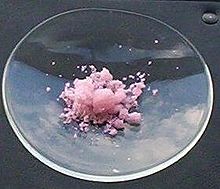
| |
| Names | |
|---|---|
| IUPAC name Erbium(III) chloride | |
| Other names Erbium trichloride | |
| Identifiers | |
| CAS Number |
|
| 3D model (JSmol) | |
| ChemSpider | |
| ECHA InfoCard | 100.030.337 |
| EC Number |
|
| PubChem CID | |
| UNII | |
| CompTox Dashboard (EPA) | |
InChI
| |
SMILES
| |
| Properties | |
| Chemical formula | ErCl3 (anhydrous) ErCl3·6H2O (hexahydrate) |
| Molar mass | 273.62 g/mol (anhydrous) 381.71 g/mol (hexahydrate) |
| Appearance | violet hygroscopic monoclinic crystals (anhydrous) pink hygroscopic crystals (hexahydrate) |
| Density | 4.1 g/cm (anhydrous) |
| Melting point | 776 °C (1,429 °F; 1,049 K) (anhydrous) decomposes (hexahydrate) |
| Boiling point | 1,500 °C (2,730 °F; 1,770 K) |
| Solubility in water | soluble in water (anhydrous) slightly soluble in ethanol (hexahydrate) |
| Structure | |
| Crystal structure | monoclinic |
| Space group | C2/m, No. 12 |
| Lattice constant | a = 6.80 Å, b = 11.79 Å, c = 6.39 Åα = 90°, β = 110.7°, γ = 90° |
| Lattice volume (V) | 479 Å |
| Formula units (Z) | 4 |
| Related compounds | |
| Other anions | Erbium(III) oxide |
| Other cations | Holmium(III) chloride, Thulium(III) chloride |
| Except where otherwise noted, data are given for materials in their standard state (at 25 °C , 100 kPa).
| |
Erbium(III) chloride is a violet solid with the formula ErCl3. It is used in the preparation of erbium metal.
Preparation

Anhydrous erbium(III) chloride can be produced by the ammonium chloride route. In the first step, erbium(III) oxide is heated with ammonium chloride to produce the ammonium salt of the pentachloride:
- Er2O3 + 10 [NH4]Cl → 2 [NH4]2ErCl5 + 6 H2O + 6 NH3
In the second step, the ammonium chloride salt is converted to the trichloride by heating in a vacuum at 350-400 °C:
- [NH4]2ErCl5 → ErCl3 + 2 HCl + 2 NH3
Structural data
Erbium(III) chloride forms crystals of the AlCl3 type, with monoclinic crystals and the point group C2/m.
Erbium(III) chloride hexahydrate also forms monoclinic crystals with the point group of P2/n (P2/c) - C2h. In this compound, erbium is octa-coordinated to form [Er(H2O)6Cl2] ions with the isolated Cl completing the structure.
Optical properties
Erbium(III) chloride solutions show a negative nonlinear absorption effect.
Catalytic properties
The use of erbium(III) chloride as a catalyst has been demonstrated in the acylation of alcohols and phenols and in an amine functionalisation of furfural. It is a catalyst for Friedel–Crafts-type reactions, and can be used in place of cerium(III) chloride for Luche reductions.
References
- Lide, David R. (1998). Handbook of Chemistry and Physics (87 ed.). Boca Raton, Florida: CRC Press. pp. 4–57. ISBN 0-8493-0594-2.
- ^ Tempelton DH, Carter GF (1954). "The Crystal Structure of Yttrium Trichloride and Similar Compounds". J Phys Chem. 58 (11): 940–943. doi:10.1021/j150521a002.
- Brauer, G., ed. (1963). Handbook of Preparative Inorganic Chemistry (2nd ed.). New York: Academic Press.
- Meyer, G. (1989). "The Ammonium Chloride Route to Anhydrous Rare Earth Chlorides—The Example of Ycl 3". The Ammonium Chloride Route to Anhydrous Rare Earth Chlorides-The Example of YCl3. Inorganic Syntheses. Vol. 25. pp. 146–150. doi:10.1002/9780470132562.ch35. ISBN 978-0-470-13256-2.
- Edelmann, F. T.; Poremba, P. (1997). Herrmann, W. A. (ed.). Synthetic Methods of Organometallic and Inorganic Chemistry. Vol. VI. Stuttgart: Georg Thieme Verlag. ISBN 978-3-13-103021-4.
- Graebner EJ, Conrad GH, Duliere SF (1966). "Crystallographic data for solvated rare earth chlorides". Acta Crystallographica. 21 (6): 1012–1013. doi:10.1107/S0365110X66004420.
- Maeda Y, Akidzuki Y, Yamada T (1998). "All-optical liquid device derived from negative nonlinear absorption effect in an erbium chloride solution". Applied Physics Letters. 73 (17): 2411–2413. Bibcode:1998ApPhL..73.2411M. doi:10.1063/1.122450.
- Dalpozzo Renato, De Nino Antonio, Maiuolo Loredana, Oliverio Manuela, Procopio Antonio, Russo Beatrice, Tocci Amedeo (2007) Erbium(iii) Chloride: a Very Active Acylation Catalyst. Australian Journal of Chemistry 60, 75-79. doi:10.1071/CH06346
- Synthesis of trans-4,5-Bis-dibenzylaminocyclopent-2-enone from Furfural Catalyzed by ErCl3·6H2O Mónica S. Estevão, Ricardo J. V. Martins, and Carlos A. M. Afonso Journal of Chemical Education 2017 94 (10), 1587-1589 doi:10.1021/acs.jchemed.6b00470
- Luche, Jean-Louis (2001-04-15), "Erbium(III) Chloride", in John Wiley & Sons, Ltd (ed.), Encyclopedia of Reagents for Organic Synthesis, Chichester, UK: John Wiley & Sons, Ltd, pp. re006, doi:10.1002/047084289x.re006, ISBN 978-0-471-93623-7
| Erbium compounds | |
|---|---|
| Lanthanide salts of halides | |||||||||||||||||||||||||||||||||||||||||||||||||||||||||||||||||
|---|---|---|---|---|---|---|---|---|---|---|---|---|---|---|---|---|---|---|---|---|---|---|---|---|---|---|---|---|---|---|---|---|---|---|---|---|---|---|---|---|---|---|---|---|---|---|---|---|---|---|---|---|---|---|---|---|---|---|---|---|---|---|---|---|---|
| |||||||||||||||||||||||||||||||||||||||||||||||||||||||||||||||||